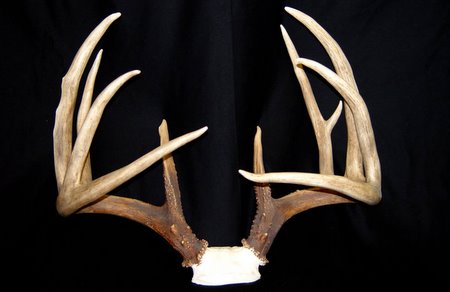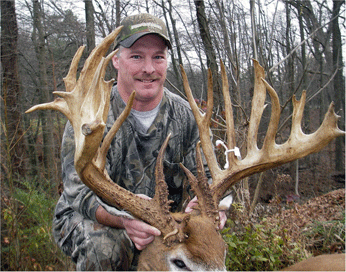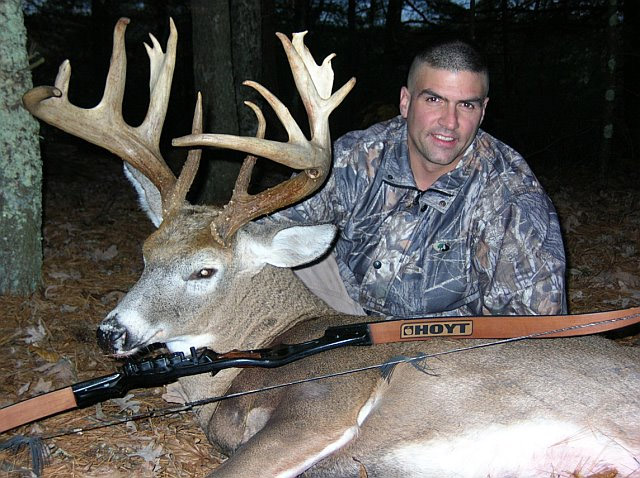Prior articles have discussed normal and abnormal points with regards to deer antlers, but today we are discussing typical and nontypical white-tailed deer antlers. Every set of antlers is classified as typical or nontypical and can be scored as either a typical or non-typical rack. This may sound confusing, but there are advantages to scoring certain sets of antlers one way or the other.
For the purposed of Boone & Crockett Club, typical antlers are those that look like “normal” buck antlers, such as a 10-point buck that has 5-points per side with matched G1s, G2s, G3s, and G4s. Typical means the antlers have antler points in the typical locations where points are found and the conformation on the buck’s rack are typical in nature.

Take, for example, the set of antlers above. Appears to be from a healthy buck, one that most of use would have been more than happy to use a tag on. One of the great things about whitetail bucks is that no two are the same. Some will look “normal” while others fall into the freak show category.
All are unique and rather amazing when you think about it, since antlers are grown and shed year after year. With as many different types of antler configurations out there, antlers are still score only 2 ways when it comes to the Boone & Crockett Club system.

Typical White-tailed Deer Antlers
Nontypical white-tailed buck antlers, on the other hand, are sets of antlers that do not look normal. These can be slightly odd looking, such as having unmatched points (say 4-points on one side and 6 on the other) or can be a totally freakish buck with 34 points going in every direction with points off points.

Nontypical White-tailed Deer Antlers
The most important thing to remember regarding scoring both typical and nontypical antlers is that having a typical, symmetrical frame is very important for the net score. When scoring a typical 8-point, for example, each point is measured and compared to the paired point on the other side of the rack. The left G1 is compared to the right G1, the left G2 to the right G2, and G3 to G3. The difference between in length between G1s is where deductions take place. The same is true for circumferences (H) as well as the main beams.
For the gross score, all the point lengths, inside spread, beam lengths, and circumferences add up for total inches. To get the net score on a typical rack, the differences in paired points, circumferences, and beam lengths are deducted. If all the points are the same length, all the circumferences are the same, and the beams are the same length, the gross and net score will be identical because there are no differences between antler sides, no deductions to be had.
For the gross score on a nontypical white-tailed deer rack, all the point lengths, inside spread, beam lengths, and circumferences add up for total inches. To get the net score on a nontypical rack, the differences in paired points, circumferences, and beam lengths are deducted. Abnormal points still add to the net score on a nontypical rack.

If there is an abnormal point on a typical set of antlers, then that point will be deducted from the net score. Why? Because it is abnormal. It does not matter if it’s a “kicker” off another point or a buck that has 5-points on one side and 6 on the other. Five of the points will be typical because they are matched, but the 6th point will be “abnormal” so to speak. In some cases, good judgement may be needed to properly score your buck and determine which points are normal and paired and which ones are abnormal.
What determines whether a buck is scored typical or non-typical? Is there a maximum amount of deductions allowed for typicals? thank you
Is it possible to cover the lingo used on different types of antlers such as “crab claws”, “flyers”, “stickers”, “drop tine”, “bumps”, “veins”, “acorn tip”, etc.? Thanks!
How do you consider a buck with a third antler? The third antler is three inches tall and there is noticeable space between the main beam with hair growing between it.
I thought the buck was killed around Ola, but I might wrong. Anyhow, this is truly a awesome deer. I heard an almost identical buck was killed around Corsicana some years back.There are really nice bucks in that area. I would be guessing to say that area is the best kept deer hunting secret in Texas.
I do not see all of the measurements needed to be taken mentioned in your article. Are the inside and outside spread both included? Do brow times get measured? Other than beam length, point length, and the 4 H measurements, what else is added in on a typical antler measurement? Thanks.
Dan, I can answer some of that for you. Buck Manager can answer whatever I leave out. You measure the tip to tip, inside, and outside spreads, but ONLY the inside spread counts in your score. Brow tines do get measured, and they are referred to as the G1’s. You ONLY get 4 mass measurements per side no matter how many typical points you have. There are more details to know such as the inside spread cannot exceed the longest main beam length, every point must be one inch in length to count, the length of a point must exceed it’s largest circumference, etc.
For a more comprehensive measuring list and a score sheet with info included, here’s the official boone and crockett scoring sheet that I print off for measuring all our deer. Cut and paste as necessary. Best of luck to you.
Dan, Hunter D summed it up well. The measurements used to calculate a gross score for a set of antlers are beam lengths, tine lengths, the 4 beam circumference measurements per side, and the inside spread (or inside spread credit).
Can anyone tell me what the little bumps around a buck’s antler bases are called?
Roger, the ridge of gnarly bumps around the very bottom of an antler, the ones that form around the actual base, are collectively referred to as the burr. The group of bumps itself is called the burr, and I have never heard of the individual bumps referred to independently.
Wow! All these bucks are simply amazing! I have a nice buck myself! And I’ve had encounters with lots of other amazing bucks that got away!
My buck is a 5 by 6, he has 6 point on the left side because he had two brow tines. It is not branched off one brow, there are just two but it’s pointing straight up (not at an angle). He is still a typical, right?
Zach, it sounds like the buck has one abnormal point, but should be scored as a typical. A buck is usually scored as a typical buck unless it has numerous abnormal points, then it’s scored non-typical.
My buck is a mainframe 8 point with a tine between the browtine and the G1 growing off the bottom of the mainbeam, but pointing outward. Would it be considered a droptine or a sticker?
I’m in a buck contest with my buddies and we figure out gross score for winner. My buddy shot a nice 8 pt but its very unique. One side has your typical 3 tines on top with a brow tine. But the other side has 2 tines on top with a brow tine, and the eighth point looks to be a second main beam 14″ long branching off just above the brow tine on this side. Where do I measure the circumferences on this unique side?
Aaron, little confused since 8 point deer only have two antler points above the brow tine, the G2 and G3. Not sure how this 8 point has 3 tines “on top”. Regardless, all bucks only get 4 circumference measurements.
On 8 point an 8 point buck, the first circumference is taken between the base (burr) and G1, the second between G1 (brow) and G2, the third between G2 and G3 and then the fourth and final circumference on at 8 point deer is taken halfway between the G3 and the tip of the main beam.
I have a deer that has a gross typical score of 154, but has 12 inches of split G2 that did not count. If I’m reading this correctly that would mean that it scores 166 nontypical?
Technically, the gross score on a typical buck does not include abnormal points. They are not even considered because the points are abnormal; and are not part of the equation. However, the gross score on a nontypical buck does include abnormal points, so you are correct.
Some hunters will incorrectly include the abnormal points when discussing gross score of a typical deer, but these points should essential be ignored.
If I shot a nine pointer and on the one beam there is simply one more point that’ll the other side is that point abnormal?
Zech, whether a point is normal or abnormal really depends on its location. For example, on a “standard” 8 point buck all points are matched, G1-G3. However, if that 8 point was a 9 point, for example, and had a G4 on only one side and that point is in the normal location for a G4, then it is a normal point. If the point is anywhere but a normal location then its abnormal. For example, a point located between normally spaced points or a kicker off of a normal point would be classified as an abnormal point.
Are Tip / Point ‘names’ based on the number of tips or the placement?
I have a typical elk rack with a 5 point left beam and a 5 point right beam. Based on the Boone&Crockett score sheet figures, the right beam’s 5th point is a normal G5 placement but the left beam’s 5th point has a “G7” placement.
So on one hand, none of the tip placements are “abnormal” but the 5th points are not paired.
Could you maybe expand on how that might be scored?
Joshua, it’s based on matched points (on both the left and right antlers) and placement. If neither of the points are paired then that’s how the set should be scored. B&C is based on symmetry, so the point placement in your situation is going to lower the net score.